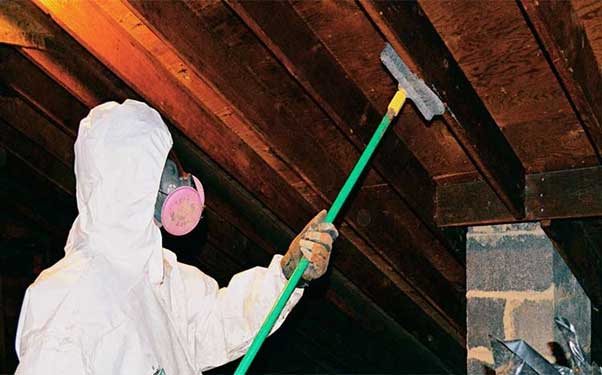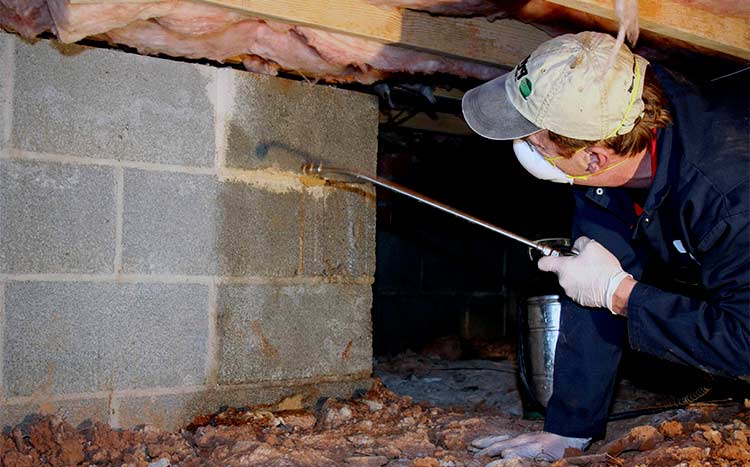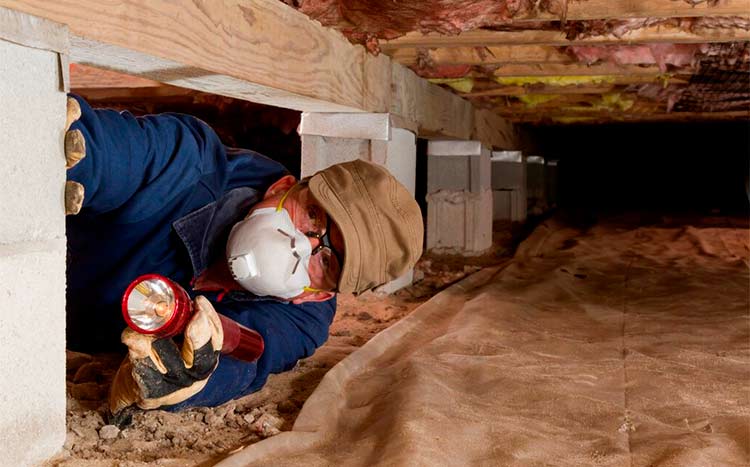A crawl space frequently acts as an unoccupied area that is very prone to mold accumulation. Eliminating mold from this space can prove to be difficult, and improper handling may lead to the spread of mold to different sections of the home.
Hiring a professional mold remediator remains the best option of completely (and safely) removing mold growing in a crawl space. Regular inspection of your crawl space for water seepage or leaks, quick-draining of pooled groundwater, and drying out your crawl space with dehumidifiers can prevent mold growth in a crawl space.
A common cause of crawl space mold is damp conditions. However, the presence of mold in a crawl space may also signify a significant moisture problem with your home.

What we cover
ToggleIs mold in crawl space dangerous?
The cold and wet condition inside a typical crawl space promotes the growth of mold. Since homeowners rarely have reason to enter these places, the mold infestation is usually out of control before it is discovered. This is dangerous because the mold spores from the crawl space can be dispersed by air within the building and inhaled by the oblivious residents resulting in mold poisoning. Also, the unchecked spread of mold anywhere within a building can cause significant property damage.
Crawl space mold can spread around your home, thrive in damp spots and on wet surfaces. The effects of crawl space mold on our property and health are:
- Property damage – mold in your home crawl space can cause mild to extensive property damage to your foundation walls and eat away at the first-floor support. Since mold thrives on the organic substrate found on most construction materials, mold can cause wood or drywall rot and compromise the structural integrity of your home.
- Destruction of household items – household items such as books, leather, upholstery, shoes, clothes, and carpets can suffer significant mold damage. Mold degrades fabric, and it feeds on the fiber, creating holes and causing rot.
- Slump in home value – buying a mold-infested home is every home shopper’s nightmare. Although most mold species are relatively harmless, most homeowners are unwilling to take the chance because of the financial and regulatory issues of buying a mold-infested property.
- Health issues – mold exposure causes mild to severe medical effects in individuals who suffer allergies. Long-term mold exposure can be fatal for individuals with respiratory diseases and suppressed immune systems.
Can mold in crawl spaces get into the house?
Yes, mold from crawl spaces can find its way into your home. The most common pathway is by air; mold spores generated from the crawl space mold can enter your home in various ways. They include:
- Stack effect – Mold infiltration can occur as a result of the stack effect. The stack effect is when warm air inside a building is displaced by cooler exterior air due to thermal differences. This process is a continuous cycle that encourages microscopic mold spores from the crawl space to circulate within the home through tiny cracks and openings between the ground floor and the crawl space.
- Human activity – there is a massive risk of unintentionally tracking dust containing mold spores directly into your home each time you visit a mold-ridden crawl space. Also, mold spores attached to your clothes during the visit find their way into the home interior when worn indoors without cleaning them.
- Ventilation systems – air conditioning or ventilating fans installed in crawl spaces with an unusually high level of airborne mold spores aid the movement of mold particles into the house.
- Access doors – opening the lower floor access into crawl spaces can create a draught of air which promotes the flow of airborne mold spores into your home living areas.
How to check for mold in crawl spaces.
Tracking down mold in a crawl space is a job for well-trained experts who have the right equipment to avoid costly errors that may require repeated attempts until the mold source is identified correctly. Crawl spaces are notoriously compact, and trying to locate mold growing in such a confined environment presents its unique challenges.
Therefore, we have identified three approaches that, when systematically performed, can help you successfully identify mold in a crawl space.
Conduct a detailed physical inspection.
This approach involves searching for identifiable signs of mold and testing for mold in crawl spaces.
A visual surface inspection for mold – as its name implies, this is a comprehensive inspection of every surface for mold. To achieve this, one requires a good knowledge of mythology, i.e., understand what different types of mold look like and what they eat. Here are a few tips on what to look out for.
- Intense musty odors signify the presence of mold.
- Look out for leaks from plumbing pipes routed through the crawl space.
- Search for food sources. Mold feeds on cellulose on wood. Look out for wet wooden beams and moisture on exposed joists.
- Discoloration of affected surfaces is a giveaway sign of mold growth. Look out for smeared-looking or mottled grey sub-flooring and blackened or whitish pigments on the building understructure.
- Mold causes decay. So, look out for signs of decay or rot on wooden beams and surfaces in the crawl space.
Perform a mold test – testing for mold can be the difference between discovering a mold reservoir and locating an unimportant mold cluster in your crawl space. Testing methods vary, but surface sampling using an adhesive tape to obtain visible mold samples for testing is probably the most accurate, convenient, and cheapest method of testing for mold presence in your crawl space.
Document a comprehensive flood or leak history of the building.
Compiling a detailed history of the building issues with flooding and water leakage can help you quickly locate mold reservoirs in the crawl space. Identifying any water-related problems that may have occurred during the building’s initial construction can help the mold inspector.
Here’s what to get you to need information about:
- If there is regular surface flooding of the crawl space.
- If the building’s original contractor adequately dried out the lumber used for construction.
- If there have been any major or catastrophic leaks in the building water piping system.
- If there had been a slow, previously undetected leak in a bathroom or kitchen pipe.
- If there was heavy rainfall, snow, or flooding during the building’s initial construction.
Signs of mold in crawl space
For most people, a single visit to the crawl space is all it takes to detect mold presence. However, recognizing mold can be a problem for some people, especially if they don’t know precisely what to look out for. Signs of mold growth in crawl space may include:
- Heavy and persistent moldy smell eliminating from your crawl space.
- Grey/whitish/black/greenish moddly spots on surfaces in your crawl space.
- Surfaces in your crawl space have a feathery feel when touched.
- The building occupiers exhibit typical mold allergy symptoms such as runny nose, sneezing, cough, itchy and watery eyes. Individuals with severe allergies or respiratory diseases may develop worse symptoms.

Who removes mold in crawl spaces?
Hiring a professional mold remediation expert remains the best option for removing mold from crawl spaces. Besides, a lack of experience or the tools required to clean out mold from very tight spaces successfully may exacerbate the mold problem, and hazardous mold spread may be released into your home. Engaging an expert to remove mold has its benefits, and they include:
- Professionals observe the appropriate safety protocols during mold remediation jobs that keep your home and family safe from mold contamination.
- Professionals don’t just remove mold; they locate the source of the mold problem and help in fixing it to prevent mold return.
- Professionals offer you excerpt advice on how to avoid future mold growth in your crawl space.
- Hiring a licensed mold expert with insurance protects you financially against any damage caused during the removal process.
Use this FREE service
HomeGardenGuides.com is a free service that quickly matches you with the top-voted local mold inspection and removal specialists. These specialists can help you with your mold problem in your crawl space, whether you need an inspection or need removal.
This service can help you get three estimates fast by real certified experts in your area in just 2 minutes.
- Scroll to the top of the page and enter your zip code.
- Answer questions about your mold crawl space job.
- Your details are forwarded to three local experts. They will send you a price estimate for the job and some friendly advice.
IMPORTANT: There is no obligation to hire. This is a free tool and service to be used at your pleasure.
Crawl space mold removal cost.
Crawl space mold remediation cost can range from $500 – $30,000, depending on the following:
- The magnitude of the mold problem.
- The crawl space’s size.
- The proposed mold removal strategy.
- How easy it is to deploy mold remediation equipment to the job site.
- Extra work such as ventilation duct cleaning and repair or replacement of mold-damaged surfaces.
Types of mold found in crawl spaces
You can find several mold species growing inside crawl spaces. Some are harmless, while others can cause serious health issues when inhaled. Their colors can categorize the different mold types to help you better understand the level of risk involved in handling them during the removal process.
White Mold
White mold, so-called because of its whitish appearance and fuzzy texture, is a range of mold types that you can find growing on wooden beams, joists, and on bare soil in the crawl space.
Examples of white mold types found growing in crawl spaces include:
- Cladosporium.
- Aspergillus.
White mold can trigger allergy symptoms and may cause serious health problems if humans inhale it. Long-term exposure to white mold species such as aspergillus can be deadly for little children and people with weak immune systems.
Yellow mold
The yellow mold that grows inside crawl spaces can come off as dirty yellow patches with a primarily flat appearance. Yellow mold species feed on the wood substrate, causing 1ooden structures to deteriorate. Alternatively, some yellow mold species are also commonly considered house-eating mold.
Examples of yellow mold found in crawl spaces include:
- Aspergillus.
- Serpula lacrymans (House-eating mold)
- Epicoccum nigrum.
- Geomyces pannorum.
Yellow mold can be destructive in wooden structures and furniture. Serpula lacrymans exclusively feed on wood, and having this species growing on exposed wooden joists and timber underfloor support can compromise your home’s structural integrity. Like other mold types, exposure to yellow mold could trigger allergic symptoms and may cause respiratory problems.
Black mold
Black mold is a grayish, green, or mottled black grayish-looking mold commonly found growing around damp spots in crawl space. Black mold has the distinction of being the deadliest household mold.
Examples of black mold are:
- Stachybotrys atra.
- Stachybotrys chartarum.
Black mold species produce mycotoxins that can trigger severe allergy attacks in humans. Stachybotrys is probably the most toxic mold species you can find growing in a crawl space. We advise hiring a mold remediation expert to remove Stachybotrys atra from your home safely.
How to prevent mold in crawl spaces
Preventing mold growth in the first place is the best strategy to combat the spread of mold in your crawl space. Constant vigilance and adopting mold-safe materials and techniques during your crawl space construction are just a few out of the several options available. Others include:
- Avoid water pooling in your crawl space and perform regular inspections for possible water leaks. Ensure to check the following:
- The foundation walls and ceiling for cracks may allow water to seep into the crawl space.
- HVAC ducts and plumbing pipes for possible leaks.
- Install vapor barriers (heavy-duty plastic sheets) over your crawl space floor and walls to trap ground moisture.
- If your home is built on a high water table, incorporate flood drains into your crawl space design to drain floodwater from your crawl space as quickly as possible.
- Clear clogged gutters and downspouts confirm that they direct water away from the building base to prevent water from flowing into your crawl space.
- Ventilate your crawl space properly. Experts recommend one sq. ft of ventilation for every 150 sq. ft space.
- Perform periodic inspections of your insulation for signs of moisture or mold damage.
To reduce humidity levels, you must ensure that dryer vents discharge air outside and not into the crawl space or your home interior. - Run a dehumidifier to collect moisture in your crawl space atmosphere during wet weather conditions to prevent high levels of humility which promises the growth of mold.
FAQ's
How do I test for mold?
You can perform a test for mold with a D.I.Y home air quality tester and mold test kit by doing surface tests or take air sampling from your home HVAC. You can send the dish to a lab for analysis on the mom’s type and treatment. D.I.Y mold test kits usually come with a petri dish, a swab kit, and a mold growth medium. Alternatively, you can hire a mold inspector to take samples from your home and analyze it at the lab.
Can I get a free mold inspection?
Most mold remediation companies offering free mold inspection use it as an a-foot-in-the-door tactic to get you committed for thousands of dollars in mold remediation costs down the line. And primarily, the ‘tests’ are performed by mold remediators, not certified inspectors. Hiring a certified mold inspector is the only guarantee of getting a professional mold infection service.
Does home insurance pay for mold remediation?
This is a grey area for most insurers, and homeowners should be aware of the policy’s wording. Most homeowners’ insurance policies won’t cover mold remediation unless a ‘covered peril causes it.’ That means your insurer won’t be liable for the mold damage caused by neglect or failure to carry out repairs such as leaking pipes. However, if the mold was caused by a ‘covered peril’ such as flooding, then your insurer will pay for the removal and associated costs. However, some homeowners’ insurance policies limit the amount of the mold cover and pay for testing or mold cleanup.















